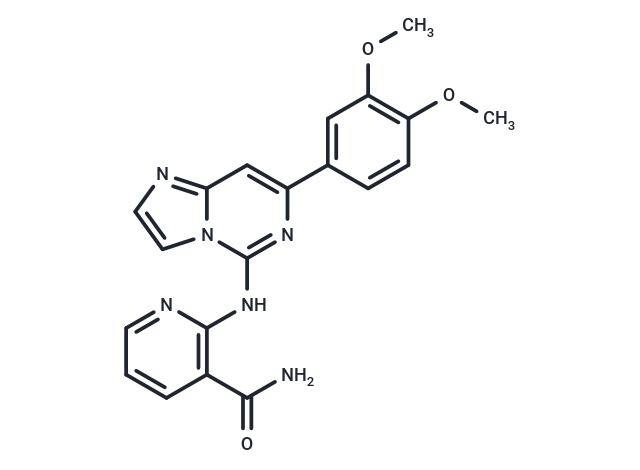Shopping Cart
- Remove All
 Your shopping cart is currently empty
Your shopping cart is currently empty

BAY 61-3606 (Syk inhibitor IV) is a potent, ATP-competitive, reversible, and highly selective inhibitor of Syk tyrosine kinase activity (Ki= 7.5 nM), exhibiting no inhibitory effect against Btk, Fyn, Itk, Lyn, and Src.

| Pack Size | Price | Availability | Quantity |
|---|---|---|---|
| 1 mg | $51 | In Stock | |
| 2 mg | $72 | In Stock | |
| 5 mg | $143 | In Stock | |
| 10 mg | $243 | In Stock | |
| 25 mg | $397 | In Stock | |
| 50 mg | $593 | In Stock |
| Description | BAY 61-3606 (Syk inhibitor IV) is a potent, ATP-competitive, reversible, and highly selective inhibitor of Syk tyrosine kinase activity (Ki= 7.5 nM), exhibiting no inhibitory effect against Btk, Fyn, Itk, Lyn, and Src. |
| In vitro | BAY61-3606 as an inhibitor of proliferation in colorectal cancer cells expressing mutant forms of K-RAS, but not in isogenic cells expressing wild-type K-RAS. In addition to its anti-proliferative effects in mutant cells, BAY61-3606 exhibited a distinct biological property in wild-type cells in that it conferred sensitivity to inhibition of RAF. In this context, BAY61-3606 acted by inhibiting MAP4K2 (GCK), which normally activates NFκβ signaling in wild-type cells in response to inhibition of RAF. BAY 61-3606 inhibited not only degranulation (IC50 values between 5 and 46 nM) but also lipid mediator and cytokine synthesis in mast cells. BAY 61-3606 was highly efficacious in basophils obtained from healthy human subjects (IC50 = 10 nM) and seems to be at least as potent in basophils obtained from atopic (high serum IgE) subjects (IC50 = 8.1 nM). B cell receptor activation and receptors for Fc portion of IgG signaling in eosinophils and monocytes were also potently suppressed by BAY 61-3606. |
| In vivo | Oral administration of BAY 61-3606 to rats significantly suppressed antigen-induced passive cutaneous anaphylactic reaction, bronchoconstriction, and bronchial edema at 3 mg/kg. Furthermore, BAY 61-3606 attenuated antigen-induced airway inflammation in rats. |
| Alias | Syk inhibitor IV |
| Molecular Weight | 390.4 |
| Formula | C20H18N6O3 |
| Cas No. | 732983-37-8 |
| Smiles | N(C=1N2C(C=C(N1)C3=CC(OC)=C(OC)C=C3)=NC=C2)C4=C(C(N)=O)C=CC=N4 |
| Relative Density. | 1.41 g/cm3 |
| Storage | Powder: -20°C for 3 years | In solvent: -80°C for 1 year | Shipping with blue ice. | ||||||||||||||||||||
| Solubility Information | DMSO: 3.9 mg/mL (10 mM), Sonication is recommended. | ||||||||||||||||||||
Solution Preparation Table | |||||||||||||||||||||
DMSO
| |||||||||||||||||||||

Copyright © 2015-2024 TargetMol Chemicals Inc. All Rights Reserved.